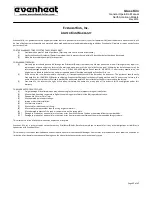
Glass Kiln
General Operation Manual
North American Models
May 2015
Page
11
of
17
Firing procedure Using Infinite Controls (Manual Control)
Once glass is loaded prop the lid open ½ to 1” with a post or firebrick and open the peephole. This allows fumes from adhesives and organic materials to
escape. Gold, silver, decals, paints release fumes while firing and will leave an unwanted finish on the glass. If you’re not firing any items such as these you
may skip this step.
The goal is to reach 1000°F in about an hour. A pyrometer is a valuable tool which displays kiln chamber temperature. You’ll need one. Talk to your
supplier. In general, 1000° is “red heat”. That is to say that once the chamber attains a nice red glow you’re about at 1000°F.
Rotate all switches to the Low position and allow the kiln to fire for 30 minutes.
Rotate all switches to the Med setting and allow to fire until the temperature reaches 1000°F. These settings and times are general and you’ll want to
adjust them to fit your kiln, load and type of work.
Once the 1000°F has been reached, close the lid completely (if propped open) and shut all peepholes.
Rotate all switches to the High position. Check the firing periodically. Continue to fire at this high setting until desired results are achieved.
Once the desired results are achieved rotate all switches to the Off position and vent the kiln to stop further changes to the glass. Venting can be
accomplished in many ways. You may prop the lid open with a post or firebrick or you may open and close the lid slightly for a number of times. The point
here is to stop further changes to the glass. Choose a technique you feel comfortable with. It must be mentioned that protective clothing, gloves and
eyewear be worn when handling a hot kiln. This is important at any stage of the firing.
Continue venting until the temperature falls to about 1100°F or so. When the chamber reaches this temperature, close the lid completely. The
temperature of the firing chamber tends to rise a bit once the lid is closed. This is normal and will generally not harm or change the glass.
The glass must now be allowed to anneal. Annealing is the process of reducing internal stresses in the glass. Your glass will have an annealing temperature,
however, it’s often unknown and often not given by the manufacturer. In this case we perform what we call a “shotgun anneal”: allowing the temperature
of the kiln to cool slowly over a period of time. In this way it’s assumed that the anneal temperature will be within the slow cooling range. Typically, this
slow cooling takes place between 1100°F and 600°F. How slow is slow? Thinner glass anneals faster than thicker glass. General rates may be between 60 to
100°F per hour. When in doubt, go slow. You can’t over anneal glass.
Once the temperature of the kiln is below your annealing range, turn off any remaining switches and allow the kiln to cool to room temperature. Once
cooled to room temperature it’s safe to remove the glass from the kiln.
Record Keeping
It’s recommended that you keep records of your firings. You will want to record what is being fired, when it’s fired, glasses used, heating and cooling times
and temperatures, switch or controller settings, venting and final results.
As mentioned in the Firing Procedure for Automatic Controls it is wise to develop your firing information on paper before actually programming the kiln.
Segments, rates temperatures and the like can be reviewed before being programmed. Not only will this act as a double check, it will provide you with a
written record. Accurate record keeping will allow you to repeat particular firings along with giving you a “feel” for what’s going on and how it happens.
Kiln Maintenance
Before Each Firing
Check the firing chamber for debris
Vacuuming your kiln before each firing will help insure that dust will not affect your ware. Look over the lid and remove any loose brick pieces.
Check all firing surfaces for cracks and kiln wash. Recoat with kiln wash if necessary.



































